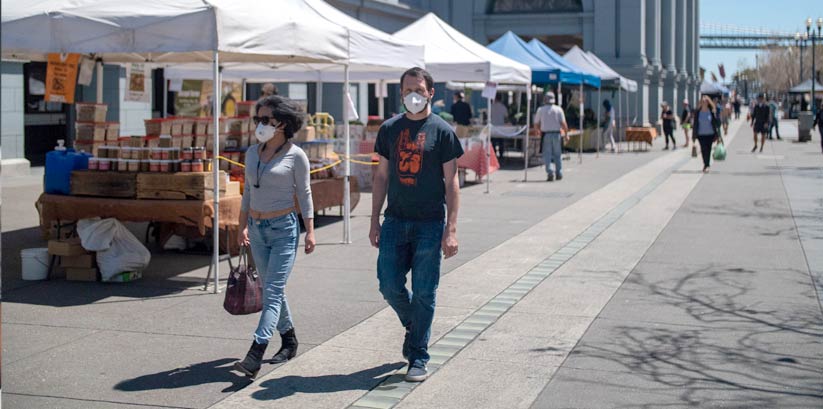Monday Moment
The Mask is the Message
And just like that, face masks are the new etiquette.
A mask symbolizes so much. It can mean tantalizing mystery, as it might at a costume party or Mardi Gras. It can signal nefarious intent if someone doesn’t want to be recognized. It can be a symbol of necessary self care in an urban area with heavy pollution, or any area beset by the airborne particles of runaway ground fires. In all these situations, a mask communicates, and the masks of the novel coronavirus are no different.
The human face and its expressions are fundamental elements of communication. If you are a devotee of medical dramas like Grey’s Anatomy or House, MD, you will have spent seasons upon seasons watching the characters read each other’s emotional messages in subtle eye movements above surgical masks. In our real world today, we don’t need to look into a stranger’s eyes, or see their entire face.
Just wearing a mask communicates the main point.
The Dance: Reconvening Everyday Life
Tomas Pueyo is a darling of the coronavirus news world, having published three intelligent, cogent analyses of the pandemic, and what we should expect as it progresses.1 In early March, he called for shelter-in-place practice, and at the beginning of April he counseled stronger leadership from the federal government. In between, he published a piece called “The Hammer and the Dance,” in which he discusses the need for heavy-handed enforcement of social distancing (the hammer) to slow transmission, and then a more nuanced, nimble approach to gradually lifting stay at home restrictions life (the dance).
And now, approximately a month after much of the country did impose shelter-in-place orders, the national conversation is shifting. Initially we needed to learn to reduce transmission and “flatten the curve” to minimize mortality and sustain the capacity of our medical infrastructure. Changing behavior is arduous and complex, and we’ve all had a crash course in it – and now we are moving to the next challenge to learn new habits. As we feel our way through figuring out how to re-energize public physical interaction and economic activity, we need to learn to wear masks in public.
To Mask or Not to Mask?
Chaos in responding to the pandemic has been frustrating – and heartbreaking – for people in all different circumstances, and with all sorts of roles. Early on, “mask” meant an N-95 mask, an industrial grade product that can filter out over 95% of airborne particles, and is considered the most effective at keeping a person safe if they are in contact with infected people. They were quickly reserved for healthcare workers and other essential personnel, and the general public was encouraged not to wear masks. It became a sign of selfishness to wear one, as you were depriving a more necessary worker of protective gear.2
Initially the CDC advised that “masks are not usually recommended in non-healthcare settings,”3 in favor of other strategies, such as self-isolation and social distancing. On April 3, they updated their guidance to finally recognize the fact of asymptomatic transmission, and to counsel the use of masks in social settings where their preferred social distancing strategies are difficult to maintain.4
Even prior to that guidance, people started taking matters into their own hands and wearing masks, whether purchased or homemade. Surveys indicate that a majority of the population is worried that social distancing may end too soon, and so masks are likely to be a feature of our routines and outfits for some time to come. There is a good deal of work underway showing the dramatic extent of asymptomatic transmission5, and making efforts to better understand it.
Collectively, we recognize the benefits of protecting our community. Wearing a mask is a show of solidarity with our people, and with all people. We’ll gather more and better data incrementally over time, but until then: let’s wear our masks. It will keep us safer, and also signal to strangers that we are willing to keep them safe, too.
1 On March 10, Tomas Pueyo published “Coronavirus: Why You Must Act Now” on Medium, sounding the alarm about how many more cases probably existed than were known, and the immediate need for shelter-in-place orders. On March 19, he published “The Hammer and the Dance,” explaining that to avoid massive mortality rates from the pandemic, we must be extraordinarily strict with social distancing to start with, and then we can “dance” through the process of allowing more interactions. His most recent piece (so far) was published April 1, titled “Out of Many, One,” a reference to the need for strong leadership and an entreaty to the federal government to step up and provide it.
2 In the Bay Area, primarily because of the heavy fires and subsequent airborne ash, many of us had N-95 masks on hand. Companies that had stockpiled masks for employees in the case of future fires were able to donate those for medical use.
3 CDC online, “Guidance for the Use of Masks to Control Seasonal Influenza Virus Transmission,” updated March 5, 2020. https://www.cdc.gov/flu/professionals/infectioncontrol/maskguidance.htm
4 CDC online, “Recommendation Regarding the Use of Cloth Face Coverings, Especially In Areas of Signficant Community-Based Transmission,” updated April 3, 2020. https://www.cdc.gov/coronavirus/2019-ncov/prevent-getting-sick/cloth-face-cover.html
5 “Antibody Study Suggests Covid-19 Could Be Far More Prevalent in the Bay Area Than Numbers Suggest.” CNBC Online, April 17, 2020. The research indicates the actual number of people who have had the virus may be 85 times as high as the number with official positive diagnoses. https://www.cnbc.com/2020/04/17/santa-clara-covid-19-antibody-study-suggests-broad-asymptomatic-spread.html
Related Articles
This commentary on this website reflects the personal opinions, viewpoints, and analyses of the North Berkeley Wealth Management (“North Berkeley”) employees providing such comments, and should not be regarded as a description of advisory services provided by North Berkeley or performance returns of any North Berkeley client. The views reflected in the commentary are subject to change at any time without notice. Nothing on this website constitutes investment advice, performance data, or any recommendation that any particular security, portfolio of securities, transaction, or investment strategy is suitable for any specific person. Any mention of a particular security and related performance data is not a recommendation to buy or sell that security. North Berkeley manages its clients’ accounts using a variety of investment techniques and strategies, which are not necessarily discussed in the commentary. Investments in securities involve the risk of loss. Past performance is no guarantee of future results.



